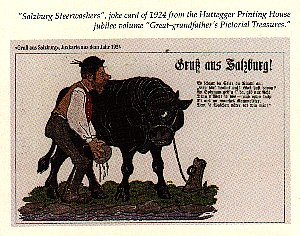|
How the Stier Roars or Bellows 
Hear The Stier Roar / Bellow
|
|
The Salzburg "Stier" Roar (or Bellow) The steer bellows three times daily, the instrument is located in a small building hung high on the outside of the wall on the north side of the palace, Hohensalzburg, The Stier which is known world-wide, is the last example of Gothic organ construction. Because of the very unique nature of the Salzburg Stier Barrel Organ, the "World Cultural Heritage" has shown deserved attention to its restoration, along with the general renovation of the Fortress/Palace Hohensalzburg. The pipes in this work, stand on an air chamber, from which they receive "compressed air" from a giant bellows. The instrument is played with a barrel, (in place of keys), on which a series of long bars (Bridges) and short notes (pins) are created, these pegs (pins) and rods (bridges) are hammered into the wooden barrel. When the Barrel turns, the pegs and rods slide under the levers of the keyframe, opening the vents (pallets) beneath the pipes and release the Wind for short or long tones (notes). The largest pipes for the deepest notes in this work of three octaves measure 3.6m. To save expensive tin, the builders 500 years ago left out some intermediate tones (notes). Transposed for the piano, one requires fewer black keys. Wolfgang Amadeus Mozart's father, Leopold (1719-1787), court composer to Salzburg, described this instrument in detail as "... pipe works like an organ and a mixture, by which the great major or minor thirds must be prominent...." This barrel contraption makes a so-called "shriek" before it has played a piece of music, which arises in the harmonic thread (F-A-C) as a pure mixture and takes place in 150 pipes. This shriek follows musical pieces whose special sound Mozart described thus; "The instrument has 200 pipes, which from the deepest to the highest notes reproduce constantly, meaning from 2 to 10 (pipes per note) rising, "Visitors can check this on the guided tour; the shorter the pipes (with increasingly higher tones), the closer they stand in a row, Leopold Mozart and his professional colleague, Johann Ernst Eberlin (1702-1762), wrote twelve works for this instrument. One for each month. Mozart accommodated the "desires of many Lovers" and adapted these twelve pieces for the piano in 1759. During renovation, music is also to be made on barrels in the character of a Gothic organ- and not offer a potpourri without style - that the Salzburg musicologist and organist Gerhard Walterskirchen rightly criticizes. The "Shriek" mentioned by Mozart is the bellow of the "Salzburg Stier".

According to legend, of course, this animal plays not a musical, but a military role; Rebellious peasants once besieged the Fortress Hohensalzburg. When food became scarce for the occupants, they struck upon a brilliant idea, Their last steer was painted and washed clean differently each day and was led around a bastion to convince the peasants that there was still enormous reserves of foodstuff. The trick worked and the peasants gave up the, apparently hopeless siege. The people of Hallein, of course, were jealous of the intelligence shown by the "Salzburg Steer washers", and took revenge for a malicious rumor from earlier days. The Salzburgers had claimed that the Hallein Burgermeister had the city portals closed after his wife's goldfinch had flown away. The people of Hallein were then teased as being goldfinch catchers. "In revenge for this sarcasm the Halleiners sent a black steer on a raft down the River Salzach. And because the Salzburgers had never seen black cattle they brought the animal on to the shore and washed it for days - to no effect. With this the intellectual balance between the Salzburg "Steer Washers" and the Hallein's "Goldfinch Catchers" was re-established, and thus, as a reminder to the good people of Salzburg of this event, the" Salzburg Stier Barrel Organ" in Fortress Hohensalzburg, always starts and ends each melody with a mighty roar. Notes The organ in the "Kraut" tower, Known as the "Salzburg Bull" is installed to warn the townspeople daily that the working day has begun. |



